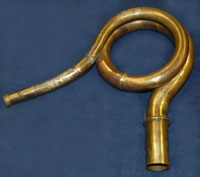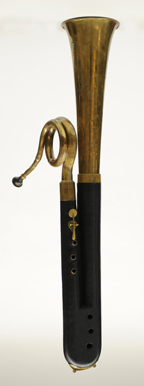
Instruments: The Serpent a pavillon


This instrument is thought to have been used exclusively in French military bands.
Much more research needs to be conducted on the serpent a pavillon. An assortment of designated does not exist nor are there any known mouthpieces that have been attributed to this instrument.




DIMENSIONS
Measurements of air column with the instrument pitched at A=440
forthcoming
As the traditional, curved serpent, the serpent d’église, entered the military bands of the late 18th century, the bass horn emerged during a time of great experimentation prior to the invention of mechanical valves. Designers sought to conceive a bass instrument that would be more sturdy, easier to hold, and offer better intonation. While bass horns, along with serpents, suffer from acoustically ill-placed fingerholes, the thickness of the bass horn’s walls permitted angled and flared drilling, offering greater flexibility in the size and placement of the tone-holes. The length of the instrument’s initial conical air-column, the bocal, was typically narrower and longer than the church serpent’s crook, and with a bell that was typically wider, the instruments design was thought to provide more control and clarity of sound. No bass horn can produce the same pure tone for each note; yet, instrumentalists could still attain proper intonation and volume to expand the sound of the bass part within the military or chamber ensemble. The bass horn integrates modern distinctions between the woodwind and brass families with the instrument seemingly more closely aligned to the bassoon. Further, the unique acoustical properties of the bass horn, when coupled with the bassoon, supplemented the lower harmonic range and low frequency energy and, similar to the effects of the serpent, greatly increased the perceived volume of the bassoon’s sound.
For a complete description of the different types of bass horns, see Bass horns and Russian bassoons by Craig Kridel

to download
a high density image
Please include the following photo credit in any public presentation:
© Craig Kridel,
Berlioz Historical Brass

Piccolo Press : ITEA Historical Instrument Section : The Tigers Shout Band : Harmoniemusik : Links